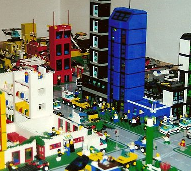Urban Planner Career
Urban Planner Career
The Real Poop
Urban planners have a lot in common with super villains. Both are goal-oriented free-thinkers. Both love to share their plans and appreciate the value of a good minion. And whether the project in question is a freeze ray or a freeway, villains and planners alike must pay close attention to detail without losing sight of the big picture—world domination.
Okay, there are some more subtle differences. Urban planners don't get cool spandex costumes, for one. And instead of plotting to destroy all humans, planners plot to organize human living spaces. The Joker probably wouldn't approve of that last part. And finally, super villains don't seem to care much about a paycheck, but you will. Expect to earn an average of almost $67,000 per year once you've got a few years of experience under your belt. Your starting salary won't be too bad either at $42,000 (source).

Urban planners are the puppet masters of our cities. They spend hours crunching data, consulting environmental impact studies, and questioning clients and citizens to see which layout will work for everyone.
Is it a good idea to put a nuclear power plant in the middle of that neighborhood, or will it lead to a new breed of warty green children? Would the traffic from a new apartment building lower the life expectancy of little old ladies crossing the street? Will bulldozing a grassy meadow unleash a plague of deer on the local gardening society?
Never fear, urban planners are paid to think this stuff through. Maybe if Pisa had hired a planner to look for building sites, it would have a straighter tower.
Being this prepared requires a pretty broad skill set. Urban planners must squeeze information from tables and statistics to boil it down into easy-to-digest report form (like a delicious, nutritious data vitamin). They must speak the mysterious language of maps, and even know how to fold one back up properly.
Urban planners are also expected to be a mixture of fixer and enforcer. They find solutions to local problems and make darn sure that any repair jobs actually stick. And an urban planner must be able to communicate. With real human beings. (No, you can't just text them.)
You might be thinking that the job title of "urban planner" sounds like a recipe for a nine-to-five office rat. But urban planners have to get around to earn their cheese. Maps only go so far, and occasionally, planners must brave the fresh air to scope out a location.
Their adventures might introduce them to some of the local (hopefully non-rabid) wildlife, such as Homo Politicus (local lawmakers) and related species like Bob the Builder and Joe Public. A well-equipped urban planner always keeps fresh batteries in her laser pointer, because she'll be expected to present her amazing ideas to clients, be they government, residential, or commercial.
Although elements of urban planning had been in place for more than 2,000 years, it's been rather haphazard until recently. The movement to coordinate the separate efforts of several professions into a unified form began in 1898 (source) and really gained traction in 1909 at the National Conference on City Planning in Washington, D.C (source).
It was sort of like Comic Con for urban planners. Only without the awesome costumes, unless you think top hats and tails qualify (actually, yes, they totally do). Harvard University saw the blueprints on the wall, and started providing professional training in 1923 (source).
Nowadays, all the cool colleges offer undergrad and master's degrees in urban planning, and it's every student's dream to get accredited with a professional planning society, like the American Institute of Certified Planners, or the Green Building Certification Institute. Heck, there's probably even a singles group for urban planners. (Not that we checked, or anything.)

Why is urban planning such a hot topic? If you do it well, people could be singing your praises 200 years from now. Just ask Pierre L'Enfant, who used Washington D.C.'s natural topography to create a city layout which stands the test of time. (You can't really ask him anymore, but Thomas Jefferson thought he was a big deal.)
Or, you could create a life-changing transit system like the twenty-four-hour New York City subway, which carries millions of people each day—with or without pants.
On the flip side of that coin, there are plenty of urban cautionary tales which make perfect scary stories to tell around the campfire. Failing to provide for future population growth can lead to crowded slums like Bahay Toro in Manila, where one fire left 10,000 residents without shelter.
Or, a city might have the opposite problem, like the Mongolian ghost town Ordos. It has plenty of buildings, but few actual residents. Strangely, the local sports teams announce sellouts for every home game.
And don't forget to take local resources into account, or you'll give your grandkids some real headaches. Los Angeles is sunny and full of beautiful people, but it has to import up to 80% of its water (source).
Want to know if you'd cut the mustard as an urban planner? Let's see.
Are your fingers chapped from running them down long columns of numbers?
Do your Lego cities have bustling economies that stomp their neighbors?
Do you constantly grill your parents about building code violations?
Then read on.
On the other hand, if you think geography is the study of the seventh letter of the alphabet…you should find something else to plan. Wedding planner, perhaps. Or apocalypse preparation.